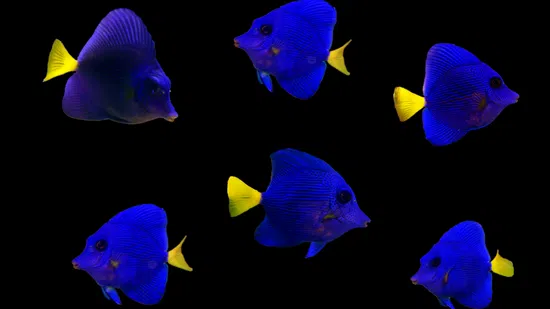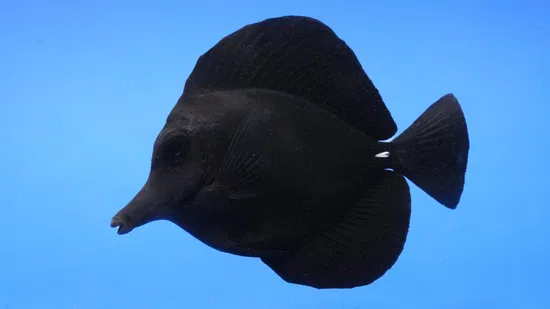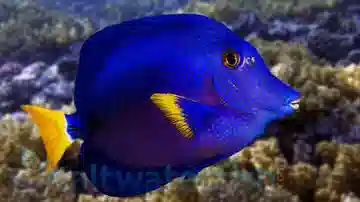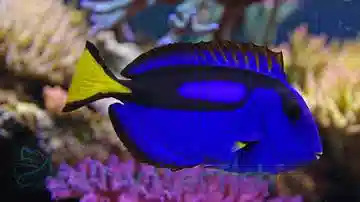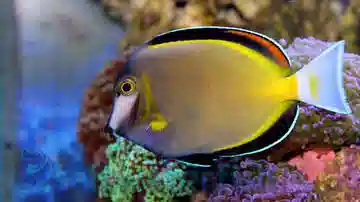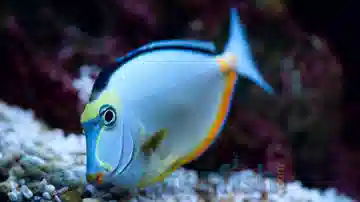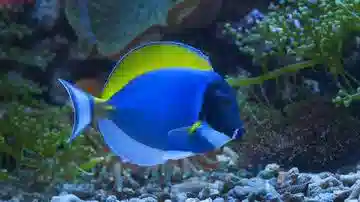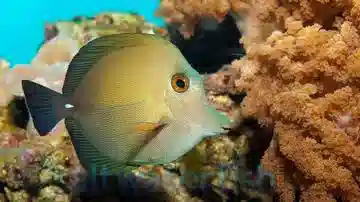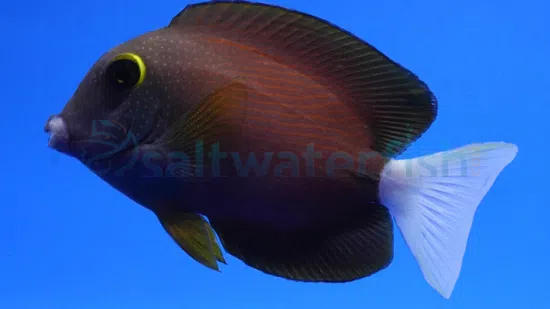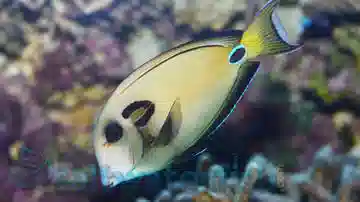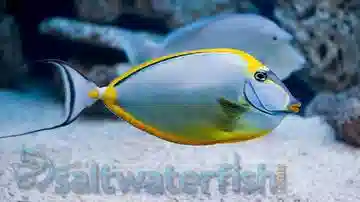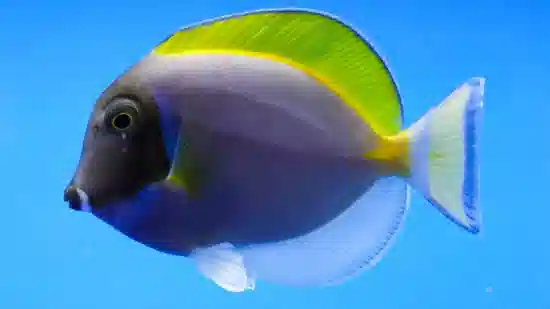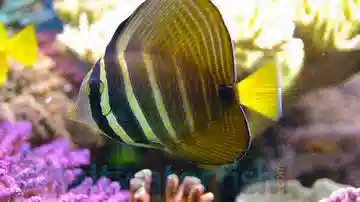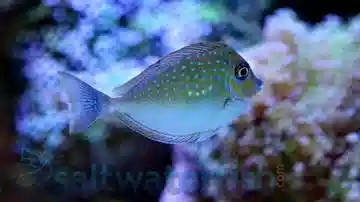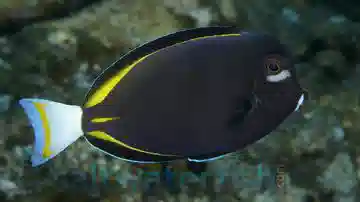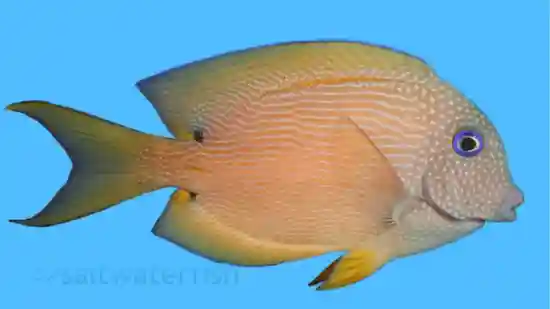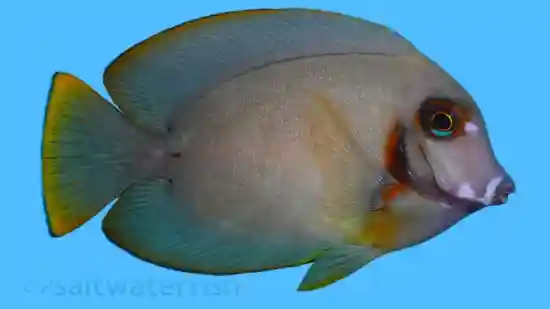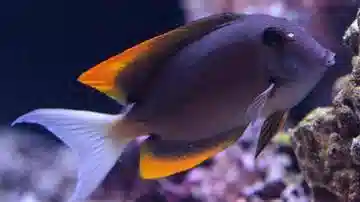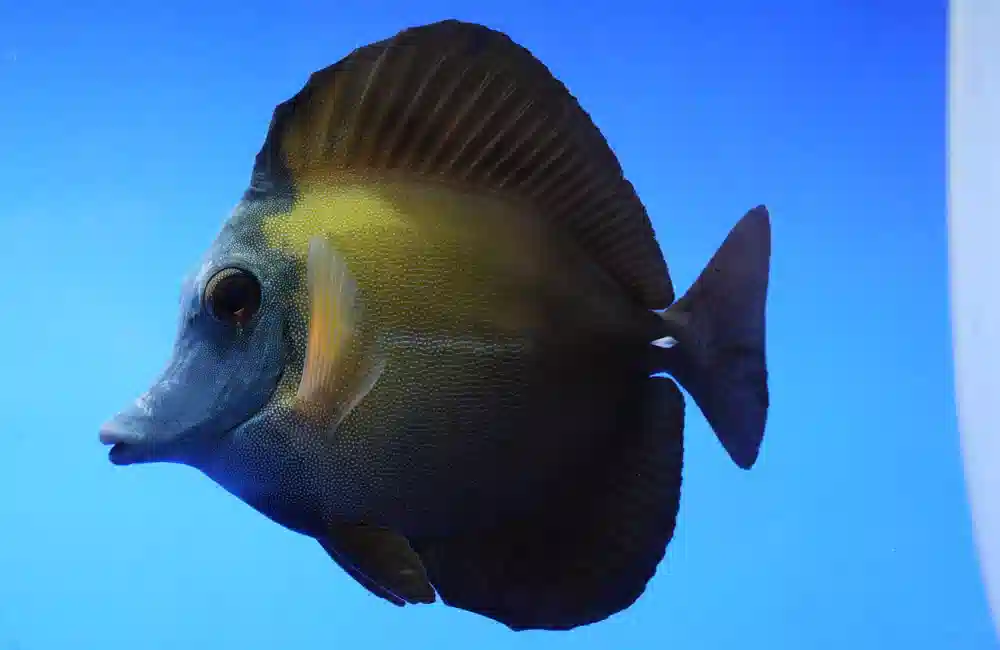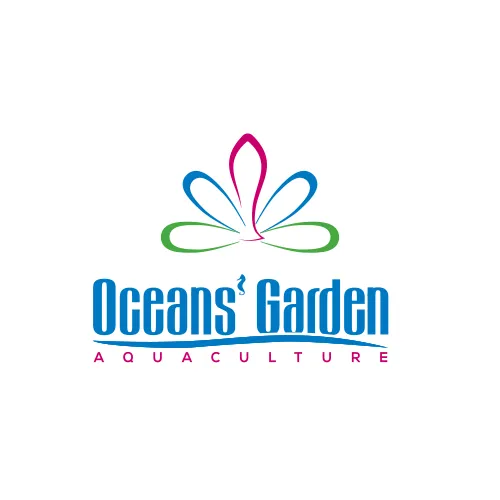Tangs In Saltwater Aquariums: FAQ
Tang fish—like Blue Hippo Tangs, as well as Kole Tangs and Royal Tangs—are herbivorous grazers that thrive on a diet packed with marine algae and vegetables. In captivity, their nutritional staples include:
- Dried nori (seaweed sheets) clipped in the tank for grazing throughout the day
- Spirulina-based flakes or pellets, formulated specifically for herbivores
- Occasional meaty treats—such as mysis or brine shrimp—to support active, fast-growing individuals
Research in aquaculture also supports this diet. Studies of Yellow Tang captive culture in the Journal of the World Aquaculture Society show that balanced feeding, particularly with algae-rich formulations, is critical for survival, growth, and long-term health.
Frequent small feedings or continuous grazing access mimic their natural behavior and support health, vibrant color, and strong immune function.
One verified Saltwaterfish.com customer, Jeff C (Sept. 4, 2017), described their Yellow Tang this way:
"Very healthy little fish! … he eats and eats on any algae, likes the seaweed."
This firsthand review beautifully underscores the importance and effectiveness of an algae-rich diet in captivity. When you combine that with Saltwaterfish's reliable 8-Day Live Guarantee and industry trust, it delivers powerful reassurance to prospective buyers.
Pro Feeding Tips:
- Use a gentle drip acclimation of 2–3 hours to minimize stress and ensure health—many aquarists consider this best practice. (saltwaterfish.com)
- Provide variety: rotate between nori, spirulina flakes/pellets, and meaty treats to cover full nutritional needs
- Avoid overfeeding protein—monitor water quality closely and remove uneaten food promptly
With this feeding strategy, backed by glowing peer-review, your tang will reward you with vibrant color, active grazing, and steady, healthy growth.
Housing multiple tangs in the same tank can work - but it's a nuanced decision dependent on tank size, species diversity, and how introductions are handled.
Successful multi-tang setups typically include different-looking species (varying colors, body shapes, and genera) to reduce visual competition and aggression. A long-time hobbyist from the Saltwaterfish forum shared:
"I house 5 tangs in a 180 gal tank for a year now with no aggression. The tangs in my 120 gal are: yellow, hippo, sailfin, purple, and powder blue."
This real-world account underlines that with thoughtful selections and sufficient space, tangs can coexist peacefully.
Another key practice is to introduce tangs simultaneously, which prevents established territorial behavior and lets them settle together. As one expert explains:
Tips for keeping multiple tangs successfully:
- Tank size matters: Aim for at least 120 gallons (long and roomy best) when housing several tangs
- Species diversity: Choose tangs that differ in genus or appearance (e.g., Blue Hippo + Sailfin)
- Move-in strategy: Add tangs together, not one at a time, to avoid territorial domination
- Use distractions: Mirrors or decoys and rearranged rockwork can reduce aggression during acclimation
In summary: Yes - multiple tangs can thrive in the same tank if you have ample space (120 gal+), introduce them together, and use species variation and environmental strategies to diffuse aggression.
Tang fish - especially popular species like Sailfin Tangs and Powder Blue Tangs - can show territorial or aggressive behavior, particularly toward other tangs or fish with similar body shapes and feeding habits. This aggression is most common in smaller tanks, during feeding time, or when a tang feels its territory is threatened.
That said, tangs are generally peaceful toward non-competing species, especially when they have plenty of swimming room and a steady supply of algae or seaweed to graze on. Adequate tank size, thoughtful species pairing, and proper introduction methods all help reduce stress and aggression.
One happy Saltwaterfish.com customer, Mike J., shared their experience on the Yellow Tang product page:
"The Yellow tang was a great addition to my tank. It is about 2 inches long which was perfect for me. It was a bit territorial when first introduced to my tank, but after about a week, all of the fish get along just fine."
Tips for minimizing tang aggression:
- Tank space is key: Aim for at least 120 gallons when adding tangs to provide enough territory for each fish. Saltwater Fish
- Pair dissimilar species: Avoid housing multiple tangs of the same genus or similar shapes - mixing, say, a Blue Hippo with a Kole Tang helps reduce visual competition
- Stagger introductions: Introduce potentially aggressive species together, or rearrange rock formations to reset territory boundaries
- Keep grazing areas stocked: Providing uninterrupted access to algae (like nori clips) helps distract and feed tangs consistently, reducing stress and aggression
In summary, while tangs can show aggression, smart tank setup, proper species selection, and dependable nutrition go a long way toward harmony.
Mindful, well-stocked tanks yield peaceful tang communities. Browse our live-guaranteed tangs confidently today.
Tangs are active, fast-growing fish that require ample horizontal swimming space to stay healthy and exhibit natural behaviors. Several sources offer species-specific recommendations:
- Smaller tangs like Ctenochaetus species do well in tanks of 75 gallons (around 4 ft long). Zebrasoma species - such as Purple Tangs - need larger space: at least 125 gallons (around 5 ft long). Larger genera like Naso can require tanks as long as 8 ft
- For most tangs, consistent guidelines align on 75-125 gallons depending on species size and tank dimensions. The key takeaway: focus on both gallons and tank length
Why Size Matters (and How It Helps Your Tang Thrive):
- Adequate space prevents stress, stunted growth, and territorial aggression, especially in school-active species
- A longer tank supports more stable water parameters and allows plenty of grazing territory, easing both aggression and boredom
- Investing in a slightly larger tank upfront saves you potential hassle and costly upgrades down the line
Bottom line: A suitable tang tank is at least 75 gallons and 4 ft long, moving up to 125 gallons and 5 ft for most common species - and even larger (6-8 ft) for big-bodied tangs.
With the right care, tang fish - like Blue Hippo Tangs, Clown Tangs, and Kole Tangs - can live 8 to 12 years in a well-maintained home aquarium, and sometimes even longer. In the wild, many tang species are known to reach 15-20 years, but captivity lifespan depends on tank size, water quality, diet, and compatibility with tankmates.
A landmark study in Marine Ecology Progress Series confirmed that Yellow Tangs, for example, are long-lived - one individual was aged at 41 years using validated otolith (ear bone) analysis and capture-mark-recapture techniques.
Long-lived tangs share a few key care factors:
- Spacious tanks (minimum 75-125 gallons, depending on species) to allow continuous swimming
- A plant-based diet with marine algae, spirulina, and supplemental protein like mysis shrimp
- Stable water parameters with low nitrates and consistent pH
- Avoidance of aggressive tankmate conflicts
Bottom line: Treat your tang to the right tank, diet, and care, and it can be a showpiece in your reef for a decade or more.
Start your journey toward a long-living tang by exploring our captive-bred and sustainably sourced options - live arrival guaranteed.
Yes - captive-bred tangs are increasingly available in the marine aquarium trade, thanks to breakthroughs in aquaculture. Species like the Yellow Tang and Kole Tang are now successfully bred in captivity, making them a sustainable alternative to wild-caught specimens.
Why choose captive-bred tangs?
- Reduced environmental impact: Captive breeding lessens collection pressure on wild reefs
- Better adaptability: These fish are accustomed to aquarium life, human presence, and prepared foods
- Lower disease risk: Many captive-bred tangs are raised in biosecure systems, decreasing exposure to parasites
- Improved survival rates: Research from the Oceanic Institute of Hawaii Pacific University shows that captive-bred Yellow Tangs have significantly higher post-shipping survival compared to wild-caught
The Oceanic Institute team documented culture and husbandry advances that improved survival and practicality for aquarists in "Development of Improved Feeding Methods in the Culture of Yellow Tang, Zebrasoma flavescens" (Journal of the World Aquaculture Society, 2016), following the first-ever captive breeding milestone in 2015. These advances translate to better adaptation to prepared foods, lower disease exposure, and higher post-shipping robustness compared to many wild fish.
Bottom line: If you want a hardy, eco-friendly, and aquarium-ready tang, captive-bred is the way to go.
Browse our captive-bred tang selection today and add a vibrant, sustainable centerpiece to your reef - backed by our live arrival guarantee.
Tang fish are generally hardy when their needs are met, but they can display clear signs of stress or unhappiness if conditions aren't ideal. Common indicators include:
- Rapid breathing or gill movement - may signal poor water quality or low oxygen
- Faded coloration or blotchy patches - often linked to stress, aggression, or illness
- Erratic swimming or hiding more than usual - can occur after aggressive encounters or sudden environmental changes
- Refusal to eat - a key warning sign in tangs, who are normally voracious grazers
- Frayed fins or visible scrapes - often from territorial disputes
- White spots or film - potential signs of marine ich or other parasites
Maintaining stable water parameters, offering ample swimming space, and feeding an algae-rich diet are crucial for preventing these issues.
Healthy behavior - active swimming, strong appetite, and vibrant color - is the best reassurance your tang is happy.
Scientific work on Yellow Tang shows that collection and handling methods directly affect stress levels and survival, reinforcing the importance of careful acclimation and stable tank conditions. A Marine Ecology Progress Series study documented how capture, handling, and decompression significantly influenced post-capture survival of Yellow Tangs in the aquarium trade.
Bottom line: Monitor your tang daily for changes in eating, color, or activity, and address issues quickly to keep them thriving.
Shop our healthy, guaranteed-live tangs today and enjoy years of vibrant, stress-free reef companionship.
Introducing a new tang to a stocked aquarium requires planning to minimize territorial disputes and stress - especially since tangs can be assertive, particularly toward similar species.
Best practices for adding a tang:
- Choose tankmates wisely - Avoid adding tangs of the same genus or similar body shape if space is limited
- Quarantine first - Keep your tang in a separate tank for at least 2-4 weeks to ensure it's disease-free before joining the display tank
- Rearrange rockwork - This disrupts established territories and reduces aggression toward the newcomer
- Use an acclimation box - Allows visual introduction without direct contact, letting existing fish get used to the tang
- Feed generously during introduction - Offering extra nori or algae sheets can distract territorial fish
- Introduce during dim lighting - Lower light levels reduce initial aggression and give the tang a chance to settle
Scientific studies on aquarium introductions show that environmental enrichment and habitat modifications - like rearranging rockwork or creating hiding zones - significantly reduce aggression during acclimation ("Individual consistency in the behaviors of newly-settled reef fish," PeerJ, 2015).
One Saltwaterfish.com customer, Cesar G (July 18, 2014), saw smooth acclimation with their Yellow Tang:
"Colorful addition to tank community, peaceful fish, gets along with existing members of the fish community."
This illustrates that proper acclimation and a balanced introduction process can lead to fast adaptation and healthy integration.
Bottom line: Plan your tang's debut carefully and you'll enjoy a vibrant, active addition that enhances your reef's beauty without disturbing harmony.
Browse our live-guaranteed tangs and start your setup the right way.
Tangs are active, algae-grazing fish that thrive when paired with non-competitive, peaceful species. The key to harmony is choosing tank mates that differ in both body shape and feeding niche, reducing territorial overlap.
Excellent tank mate options include:
- Clownfish (e.g., Ocellaris, Percula) - Hardy, colorful, and occupy different zones of the tank
- Wrasses (fairy, flasher, cleaner) - Active swimmers that complement tang activity
- Gobies and blennies - Bottom dwellers that won't compete for the same space or food
- Anthias and chromis - Schooling fish that add motion without threatening tangs
- Peaceful reef-safe angelfish - Can coexist in larger systems
Avoid keeping tangs with other tangs of the same genus or similar body shape unless you have a very large tank (120+ gallons) and introduce them simultaneously.
Science on fish tank compatibility supports this approach: environmental complexity (added rockwork, hiding places, swimming room) significantly reduces fish aggression in captive systems ("Fish welfare: current issues in aquaculture." Applied Animal Behaviour Science). When aggression is low, compatible species with varied feeding niches coexist with minimal stress.
Bottom line: Select fish with different shapes, diets, and territories to keep your tang stress-free and your reef community thriving.
Browse our live-guaranteed tangs and compatible species to build a peaceful, vibrant aquarium.

